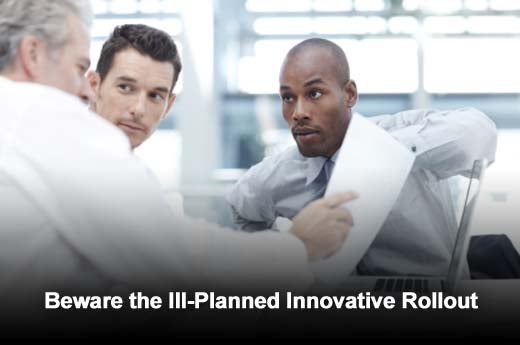It happens repeatedly. A company adopts a new technology platform that ostensibly will ease the workload, streamline operational processes and result in overall gains in efficiency and budget spending. The intention is spot-on but the execution is decidedly less so. A post-mortem will usually reveal errors in the execution but misses the real culprit: planning errors. While Garbage In – Garbage Out (GIGO) is true for any process, it is especially apparent in change initiatives. If the initiative is not planned properly, the end result will almost always reflect that lack of planning.
Moe Glenner, founder and president of PURELogistics, a leading consulting firm that specializes in organizational change, frequently observes companies that attempt technology-based change initiatives with the latest and greatest new technologies. Many believe that the provider of this technology will also ensure that their technology will successfully effectuate the intended changes. They effectively defer the planning, execution and most importantly control to this third party. More times than not, this recipe fails and takes the change initiative down with it. The result: Blame the technology and try to find a “better” technology. In other words, they blame the equipment and not themselves.
When Glenner’s clients engage his consulting services to help effectuate change, he advises them that successful change involves a three-step process: plan, communicate and execute. These are not mutually exclusive, as each step comprises elements of the other two steps.
Click through for a three-step plan to a successful innovation rollout, as identified by Moe Glenner, founder and president of PURELogistics, a consulting firm that specializes in organizational change.
Since planning is the most critical step, most of your attention should be here. Successful planning necessarily means an objective discovery of the real problem driving the change. Frequently the stated and/or obvious problem is not the real problem, rather a symptom of a bigger underlying issue. You can better discover the real issue by channeling your inner four-year-old and repeatedly asking why. In total quality management (TQM), the five-why process is a useful tool to achieving real issue discovery.
For example, if you are having trouble staying compliant with the Unsafe Driving portion of CSA:
- Q1: Why are we having this trouble?
A1: We’re ticketed too often for speeding, illegal lane changes, etc. - Q2: Why are we getting ticketed so often?
A2: Because our drivers are rushing to make their deliveries. - Q3: Why do they need to rush to make their deliveries?
A3: Because their schedules require them to make x number of daily deliveries. - Q4: Why do we need to schedule so many deliveries per driver?
A4: Because otherwise we can’t meet our service commitments. - Q5: Why are our service commitments so tight?
A5: Because the competitive landscape requires them.
The five-why process doesn’t have to repeat five times and it could actually be more than five questions. When you hit a why that you don’t have a clear answer for, you likely are at the real issue.
Once you have discovered the real issue, you need to properly define the scope of both the problem and its intended solution. A frequent planning occurrence is when the problem is clearly defined, but the solution slowly expands to include more than just the problem. In project management terms, this is called ‘scope creep.’ While it is admirable that a solution goes well beyond what it’s intended for, if the ‘well beyond’ is not planned for, it could compromise the entire initiative. The signs of scope creep will usually include budget and time overruns.
Once the scope has been established, proper risk management must be employed. What are the risks involved with rolling out this new technology? Going back to the unsafe driving example, if it’s an EBOM rollout, will your veteran drivers have trouble with it? If they do have trouble, can you provide them the proper support? With the difficulty in finding new drivers, what is the risk with rolling out this initiative and possibly losing some veteran drivers? What is the plan if you do lose these drivers? While you cannot possibly plan for every contingency, you can plan for every category of risk. This will give you a significant head start in successfully addressing the problem and continuing on unabated.
There is no such thing as over-communication. The key is to provide honest, constant and relevant communication between the change team members, upwards to senior executives and outwards to those that will be affected by the change. This communication must take place in every step of the change process for the initiative to be successful. Since most of us resist change primarily due to the fear of the unknown, we must make special and concerted efforts to combat this through every form of organizational communication (i.e., face-to-face, email, videoconferencing, etc.). Most importantly, if we don’t have an immediate answer, we must honestly and in a timely fashion communicate this as well.
Assuming that you have planned and communicated properly, you still must execute according to plan. If you have planned properly, then the likely ‘hiccups’ inherent in any change initiative will have been planned for and can be addressed according to plan.
The end result will not be an ill-planned innovative rollout, but a rollout that encompasses the best of change management and, most importantly, accomplishes its intended goal(s).








